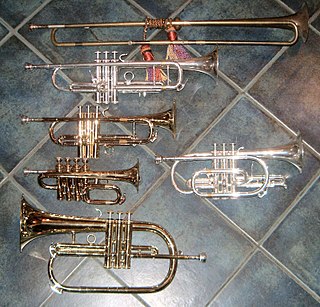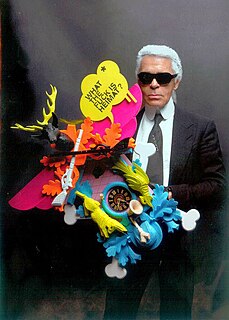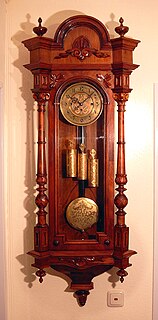
A brass instrument is a musical instrument that produces sound by sympathetic vibration of air in a tubular resonator in sympathy with the vibration of the player's lips. Brass instruments are also called labrosones or labrophones, from Latin and Greek elements meaning 'lip' and 'sound'.

A musical ensemble, also known as a music group or musical group, is a group of people who perform instrumental or vocal music, with the ensemble typically known by a distinct name. Some music ensembles consist solely of instrumentalists, such as the jazz quartet or the orchestra. Other music ensembles consist solely of singers, such as choirs and doo wop groups. In both popular music and classical music, there are ensembles in which both instrumentalists and singers perform, such as the rock band or the Baroque chamber group for basso continuo and one or more singers. In classical music, trios or quartets either blend the sounds of musical instrument families or group together instruments from the same instrument family, such as string ensembles or wind ensembles. Some ensembles blend the sounds of a variety of instrument families, such as the orchestra, which uses a string section, brass instruments, woodwinds and percussion instruments, or the concert band, which uses brass, woodwinds and percussion.

The trumpet is a brass instrument commonly used in classical and jazz ensembles. The trumpet group ranges from the piccolo trumpet with the highest register in the brass family, to the bass trumpet, which is pitched one octave below the standard B♭ or C Trumpet.

The tuba is the lowest-pitched musical instrument in the brass family. As with all brass instruments, the sound is produced by lip vibration – a buzz – into a mouthpiece. It first appeared in the mid-19th century, making it one of the newer instruments in the modern orchestra and concert band. The tuba largely replaced the ophicleide. Tuba is Latin for "trumpet".

An automaton is a relatively self-operating machine, or control mechanism designed to automatically follow a sequence of operations, or respond to predetermined instructions. Some automata, such as bellstrikers in mechanical clocks, are designed to give the illusion to the casual observer that they are operating under their own power. Since long ago, the term is commonly associated with automated puppets that resemble moving humans or animals, built to impress and/or to entertain people.

Horology is the study of the measurement of time. Clocks, watches, clockwork, sundials, hourglasses, clepsydras, timers, time recorders, marine chronometers, and atomic clocks are all examples of instruments used to measure time. In current usage, horology refers mainly to the study of mechanical time-keeping devices, while chronometry more broadly includes electronic devices that have largely supplanted mechanical clocks for the best accuracy and precision in time-keeping.

A cuckoo clock is, typically, a pendulum clock that strikes the hours with a sound like a common cuckoo call and has an automated cuckoo bird that moves with each note. Some move their wings and open and close their beaks while leaning forwards, whereas others have only the bird's body leaning forward. The mechanism to produce the cuckoo call has been in use since the middle of the 1700s and has remained almost without variation.

A clockmaker is an artisan who makes and/or repairs clocks. Since almost all clocks are now factory-made, most modern clockmakers only repair clocks. Modern clockmakers may be employed by jewellers, antique shops, and places devoted strictly to repairing clocks and watches. Clockmakers must be able to read blueprints and instructions for numerous types of clocks and time pieces that vary from antique clocks to modern time pieces in order to fix and make clocks or watches. The trade requires fine motor coordination as clockmakers must frequently work on devices with small gears and fine machinery.

A music box or musical box is an automatic musical instrument in a box that produces musical notes by using a set of pins placed on a revolving cylinder or disc to pluck the tuned teeth of a steel comb. The popular device best known today as a "music box" developed from musical snuff boxes of the 18th century and were originally called carillons à musique. Some of the more complex boxes also contain a tiny drum and/or bells in addition to the metal comb.

Carnival glass is moulded or pressed glass to which an iridescent surface shimmer has been applied. It has previously been referred to as aurora glass, dope glass, rainbow glass, taffeta glass, and disparagingly as 'poor man's Tiffany'. The name Carnival glass was adopted by collectors in the 1950s as items of it were sometimes given as prizes at carnivals, fetes, and fairgrounds. However, evidence suggests that the vast majority of it was purchased by households to brighten homes at a time when only the well-off could afford bright electric lighting, as its finish catches the light even in dark corners. From the beginning of the 20th century, carnival glass was mass-produced around the world, but largely and initially in the U.S. It reached the height of its popularity in the 1920s, though it is still produced in small quantities today.
A natural trumpet is a valveless brass instrument that is able to play the notes of the harmonic series.

The German Clock Museum is situated near the centre of the Black Forest town of Furtwangen im Schwarzwald (Germany), a historical centre of clockmaking. It features permanent and temporary exhibits on the history of timekeeping. The museum is part of the local technical college.

Martial music or military music is a specific genre of music intended for use in military settings performed by professional soldiers called field musicians. Much of the military music has been composed to announce military events as with bugle calls and fanfares, or accompany marching formations with drum cadences, or mark special occasions as by military bands. However, music has been employed in battle for centuries, sometimes to intimidate the enemy and other times to encourage combatants, or to assist in organization and timing of actions in warfare. Depending on the culture, a variety of percussion and musical instruments have been used, such as drums, fifes, bugles, trumpets or other horns, bagpipes, triangles, cymbals, as well as larger military bands or full orchestras. Although some martial music has been composed in written form, other music has been developed or taught by ear, such as bugle calls or drum cadences, relying on group memory to coordinate the sounds.
An offstage instrument or choir part in classical music is a sound effect used in orchestral and opera which is created by having one or more instrumentalists from a symphony orchestra or opera orchestra play a note, melody, or rhythm from behind the stage, or having a choir of singers sing a melody from behind the stage.

Johann Baptist Beha was a prestigious Black Forest clockmaker born in Oberbränd (Eisenbach). He was trained by his father, the master clockmaker Vinzenz Beha (1764-1868), in his workshop where he built around 365 clocks between 1839 and 1845. At that time V. Beha was already known for the quality of his clocks, he made the so-called Shield cuckoo clocks.

The cuckoo clock, more than any other kind of timepiece, has often featured in literature, music, cinema, television, etc., in the Western culture, as a metaphor or allegory of innocence, childhood, old age, past, fun, mental disorder, etc. It has apparently been viewed more as a symbol or a toy -a folksy musical apparatus with animated figures- fascinating and a bit mysterious rather than as a serious timekeeper.

Emilian Wehrle (1832 – 1896, born in Schönenbach, was a reputed Black Forest clockmaker famous for his high-quality musical clocks. These musical clocks included the trumpeter clock, flute clock, singing bird clock, and rooster clock. These timepieces call the hour with the sound of a trumpeter, flute, bird and rooster respectively. He was also a maker of cuckoo clocks, but these were not the primary focus of the firm.

The Cuckooland Museum, previously known as the Cuckoo Clock Museum, is a museum that exhibits mainly cuckoo clocks, located in Tabley, Cheshire, England. The collection comprises 300 years of cuckoo clock-making history, since the very earliest examples made in the 18th to the 21st century.

Craftsmanship of Black Forest clockmakers dates back to mid of the 17th century. A specialized branch of Black Forest clockmakers are the manufacturers of cuckoo clocks.

Gustav Eduard Becker was a German clockmaker and founder of the brand Gustav Becker.

















